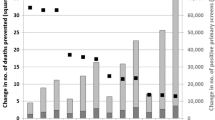Abstract
Cytology-based screening programs for cervical cancer have been effective in reducing cancer incidence and preventing premature deaths worldwide. However, there is concern about the relatively low sensitivity of current screening procedures. Although the causal association between infection with certain high-risk types of human papilloma virus (HPV) and the development of cervical cancer has been clearly established, testing for the major risk factor is not part of current screening practice. We created a tree decision model over time to evaluate different policy choices for implementing a population-based screening program. Results of the economic analysis indicate that testing with any implemented HPV DNA testing (stand alone or in combination with the Papanicolaou smear) is superior to cytology and measures presently in use. Additional costs per life-years gained cannot be reported because the HPV branches had fewer discounted overall costs (€222 million vs. €82 and €76 million, respectively), and they saved more life years (19,599 vs. 19,163 and 903, respectively) then the smear alternative. Any HPV DNA testing is preferable over the current state of the art performed in Germany. This is true not only for economic reasons but also for life-years gained. Therefore HPV DNA testing must become an essential component to back up the relatively weak sensitivity of the standard procedure.



Similar content being viewed by others
References
Perry MA (2001) How can the uptake of cervical cytology screening be improved? Nurs Stand 16:33–36
Ferris DG, Wright TC Jr, Litaker MS, et al (1998) Comparison of two tests for detecting carcinogenic HPV in women with Papanicolaou smear reports of ASCUS and LSIL. J Fam Pract 46:136–141
Schiffman MH, Bauer HM, Hoover RN, et al (1993) Epidemiologic evidence showing that human papillomavirus infection causes most cervical intraepithelial neoplasia. J Natl Cancer Inst 85:958–964
Myers ER, McCrory DC, Subramanian S, et al (2000) Setting the target for a better cervical screening test: characteristics of a cost-effective test for cervical neoplasia screening. Obstet Gynecol 96:645–652
Walboomers JM, Jacobs MV, Manos MM, et al (1999) Human papillomavirus is a necessary cause of invasive cervical cancer worldwide. J Pathol 189:12–19
Bosch FX, Manos MM, Munoz N, et al (1995) Prevalence of human papillomavirus in cervical cancer: a worldwide perspective. International Biological Study on Cervical Cancer (IBSCC) Study Group. J Natl Cancer Inst 87:796–802
Cuzick J, Terry G, Ho L, et al (1992) Human papillomavirus type 16 in cervical smears as predictor of high-grade cervical intraepithelial neoplasia. Lancet 339 959–960 (erratum 339:1182)
Myers ER, McCrory DC, Nanda K, et al (2000) Mathematical model for the natural history of human papillomavirus infection and cervical carcinogenesis. Am J Epidemiol 151:1158–1171
Fairley CK, Tabrizi SN, Gourlay SG, et al (1995) A cohort study comparing the detection of HPV DNA from women who stop and continue to smoke. Aust N Z J Obstet Gynaecol 35:181–185
Solomon D, Davey D, Kurman R, et al (2002) The 2001 Bethesda System: terminology for reporting results of cervical cytology. JAMA 87:2114–2119
Nindl I, Lorincz A, Mielzynska I, Petry U, et al (1998) Human papillomavirus detection in cervical intraepithelial neoplasia by the second-generation hybrid capture microplate test, comparing two different cervical specimen collection methods. Clin Diagn Virol 10:49–56
Reid R, Greenberg MD, Lorincz A, et al (1991) Should cervical cytologic testing be augmented by cervicography or human papillomavirus deoxyribonucleic acid detection? Am J Obstet Gynecol 164:1461–1469; discussion 1469–1471
Cuzick J, Szarewski A, Terry G, et al (1995) Human papillomavirus testing in primary cervical screening. Lancet 345:1533–1536
Ratnam S, Prafull G, Franco E, et al (1999) Utility of HPV testing in combination with Papanicolaou smear in primary cervical screening. Presented at the 17th International Papillomavirus Conference, Charleston
Gurley M, Carter CD, Bounassif S, et al (1999) Does HPV status have a role in the management of women with abnormal cervical cytology? Presented at the 17th International Papillomavirus Conference, Charleston
Cuzick J, Sasieni P, Davies P, et al (1999) A systematic review of the role of human papillomavirus testing within a cervical cancer screening programme. Health Technol Assess 3:14
Mougin C, Gay C, Riethmuller D, et al (1999) Detection of human papillomavirus by the Hybrid Capture II system: a French study of 595 women. Presented at the 17th International Papillomavirus Conference, Charleston
Clavel C, Masure M, Bory JP, et al (1999) Human papillomavirus detection by the Hybrid Capture II assay is a sensitive test to detect in routine high grade cervical lesion. Presented at the 17th International Papillomavirus Conference, Charleston
Schneider A, Hoyer H, Lotz B, et al (2000) Screening for high-grade cervical intra-epithelial neoplasia and cancer by testing for high-risk HPV, routine cytology or colposcopy. Int J Cancer 89:529–534
Anonymous (2003) Gynaecologists vote for HPV testing as routine procedure [in German]. Aerztezeitung, march 28th, p 1
Bovicelli A, Bristow RE, Montz FJ (2000) HPV testing: where are we now? Anticancer Res 20:4673–4680
Ballegooijen M van, van den Akker-van Marle ME, Warmerdam PG, et al (1997) Present evidence on the value of HPV testing for cervical cancer screening: a model-based exploration of the (cost-)effectiveness. Br J Cancer 76:651–657
Iftner T, Menton S, Menton M, et al (2000) HPV DNA testing significantly increases the detection rate for high-grade cervical cancer neoplasia in a low risk screening population in Germany. Presented at the 18th International Papillomavirus Conference, Barcelona
Clavel C, Masure M, Gabriel R, et al (2000) Human papillomavirus testing in primary screening: has the time come? Presented at the 18th International Papillomavirus Conference, Barcelona
Wright TC Jr, Cox JT, Massad LS, et al (2001) 2001 consensus guidelines for the management of women with cervical cytological abnormalities. JAMA 287:2120–2129
Hildesheim A, Hadjmichael O, Schwartz PE, et al (1999) Risk factors for rapid onset cervical cancer. Am J Obstet Gynecol 180:571–577
Petry KU, Böhmer G, Iftner T (2002) Factors associated with an increased risk of prevalent and incident grade III cervical intraepithelial neoplasia and invasive cervical cancer among women with Papanicolaou tests classified as grades I or II cervical intraepithelial neoplasia. Am J Obstet Gynecol 186:28–34
Acknowledgements
The data from the German trials in this study were collected by assessing the Hybrid Capture II array manufactured by Digene Corporation, Gaithersburg, Md., USA. These trials were supported by an unrestricted grant from Digene Corporation to the participating universities.
Author information
Authors and Affiliations
Corresponding author
Rights and permissions
About this article
Cite this article
Mittendorf, T., Petry, K.U., Iftner, T. et al. Economic evaluation of human papillomavirus screening in Germany. HEPAC 4, 209–215 (2003). https://doi.org/10.1007/s10198-003-0187-0
Issue Date:
DOI: https://doi.org/10.1007/s10198-003-0187-0




